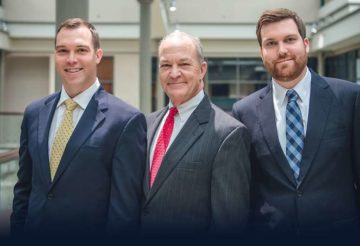As explained by the Centers for Disease Control and Prevention (CDC), while bicycles account for only 1 percent of the traffic on U.S. roadways, they account for around 2 percent of all traffic fatalities and result in injuries to around 130,000 people each year.
One of the most dangerous aspects of riding a bicycle on a public roadway is contending with the driving practices of other roadway users. Here is a look at some of the most common bicycle accidents caused by motorists, who these accidents affect, and how to recover compensation if you are injured or lose a loved one in a bicycle accident.
Portrait of a Bicycle Accident
Bicycle accidents can occur in any city or small town and can result in injuries to riders of any age. However, there are certain types of places where these accidents are more likely to occur, and certain people are more commonly involved.
Here are some common characteristics of bicycle accidents in the U.S.:
- The number of children injured in bicycle accidents has diminished due to increased awareness of bicycle safety in school zones. Still, people between the ages of 10 and 24 account for around one-third of all emergency room visits for bicycle accident injuries.
- Those most likely to be killed in bicycle accidents are adults between 55 and 69.
- In all age groups, male bicyclists are far more likely to become victims of an accident than females, with a death rate that is six times higher and an injury rate that is five times higher.
- Bicycle accidents are far more common in urban locations than in rural ones due to the proximity of the rider to other fast-moving types of traffic, including passenger cars, commercial trucks, and buses.
- Around 64 percent of all bicycle accidents occur in areas away from an intersection, and these accidents often involve vehicles traveling at a higher rate of speed.
- Bicycle accidents most commonly occur during the evening hours of 6 p.m. to 9 p.m. during the week and the nighttime hours between 9 p.m. and 12 a.m. on the weekends. These times coincide with when there is often heavier traffic due to people heading home from work during the week and heading out for a night on the town which often involves the consumption of alcohol—on the weekends.
- While many rely on bicycles as their primary source of transportation, bicycle riding is most often an activity partaken in warm months. The prevalence of bicycle accidents increases in the summer months.
Causes of Bicycle Accidents
An estimated 30 percent of injuries and deaths involved in bicycle accidents occur as a result of a collision with a vehicle. Other accidents occur due to a collision with a stationary object or the rider falling off the bike. The forward motion of the bicycle and rider stops either by a collision with the ground or friction against an asphalt road.
Here are some of the most common bicycle accidents that result from the negligence of another roadway user or other party.
The Right Cross
A right cross accident occurs when a motorist pulls onto the roadway from a side street, private drive, or parking lot on the right side of the road into the path of an approaching bicyclist. This either results in the car striking the bike with its front bumper or causing the bicyclist to broadside the car. Right cross accidents are commonly caused by the motorist failing to yield the right-of-way when entering the road due to distraction or even a phenomenon known as inattentional blindness.
Inattentional blindness refers to how the brain processes information in a chaotic environment, such as a busy roadway. Because a driver can't take in all the information presented, their brain will instead focus on the largest hazards and most pressing needs of the situation, such as fast-moving cars and trucks and a break in the traffic of that particular type of vehicle in which to pull into the travel lane. Inattentional blindness is the truth behind one of the most common statements made after a bicycle accident occurs: "I didn't even see them."
The Left Cross
A left cross bicycle accident occurs when a driver attempts to make a left-hand turn most often at an intersection with a solid green light rather than a solid arrow. Left-turning drivers must yield the right-of-way to cars coming straight through the intersection in opposing travel lanes at solid green lights. Instead, due to many of the same factors that cause right cross accidents, the driver fails to notice an approaching bicycle and pulls into its path while attempting to complete the turn.
While riders must take safety precautions such as wearing brightly colored clothing, pulsing lights, or a headlight on the front of their bike, the motorist must ensure that the lane is clear before turning.
The Right Hook
The right hook is another common type of bicycle accident, and it occurs when the bicyclist is riding in the bicycle lane or on the far right side of the roadway. A vehicle attempts to turn right into its path, causing the bicycle to broaden the vehicle. This involves a larger vehicle, such as a bus or tractor-trailer, with a significant blind spot on the passenger side that prevents the driver from knowing if other roadway users are in their path.
Dooring
A dooring accident occurs when the occupant of a parked vehicle opens the door into an approaching cyclist. This generally causes the bicyclist to collide with the door or swerve dangerously into another travel lane to avoid it.
Many safety experts argue that the owner of the car must not infringe on the travel lane when entering or exiting their vehicle. Still, they blame cities with insufficient space for drivers to enter or exit their vehicles without risking their doors (or themselves) encroaching on bike lanes.
Rear-End Accidents
Many U.S. drivers don't know the traffic laws regarding bicyclists and their rights. Unfortunately, many drivers are also aware of the rules but think they can make the bicycle they're traveling behind move quickly if they follow it very closely. This often results in a motor vehicle having a rear-end collision with the bicycle. This type of accident is particularly serious for bicyclists, as the collision will generally propel them over the front of the bike, causing them to hit the pavement, commonly with their head.
Alcohol-Impaired Accidents
Many bicycle accidents result from drivers impaired by alcohol or drugs.
Alcohol impairment creates several deficits to the skills needed for safe driving or riding, including:
- The ability to track moving targets.
- The ability to multitask.
- The ability to control lane position and speed.
- The ability to brake effectively and respond appropriately in emergency driving situations.
- The ability to make good driving or riding decisions.
Accidents That Occur While a Vehicle Is Overtaking a Bicycle
The right hook is a common accident when a vehicle overtakes a bicycle and turns promptly after passing the bike.
There are other types of accidents that also commonly occur when a vehicle is overtaking a bicycle, including:
- Accidents result from the driver encroaching on the bicycle lane or the area of the roadway where the bicyclist is riding, sideswiping the bike, and knocking it off the road.
- Accidents occur when a driver fails to check blind spots for bicyclists when changing lanes.
- Accidents occur when a driver speeds past a bicyclist, causing them to lose control of the bike.
Bicycle Accidents Involving Parked Cars and Other Objects
While collisions with motor vehicles account for the largest portion of bicyclists killed or injured in accidents, injuries and death can also occur for cyclists involved in collisions with parked cars and other objects. Some objects commonly resulting in accidents include roadside signs, trees, potholes, curbs, medians, and even animals.
To recover compensation, bicyclists injured in an accident with a stationary object must prove that it was in an unreasonably risky location to show that the accident resulted from someone else's negligence.
Examples include:
- Cars are parked in areas designated for bicyclists with no parking signs.
- Deep or dangerous potholes result from a lack of maintenance performed by the staff of the governmental area responsible for the road.
- Bicycle lanes that do not provide adequate protection from other moving traffic or lanes located near parking areas.
- Accidents resulting from animals being allowed to run at large violate local leash laws.
What to Do After a Bicycle Accident Resulting in Injury or Death?
If you were injured or have lost a loved one in a bicycle accident, contact an experienced bicycle accident lawyer to determine if you can seek compensation.
This process usually involves seeking compensation from the at-fault party's liability insurance policy. Suppose the provider of this policy fails to compensate the claim. In that case, it can be filed as a civil court personal injury or wrongful death lawsuit for a judge or jury to determine liability and compensation.
What You Need to Prove In Your Bicycle Accident Claim?

To have a successful outcome to your bicycle accident claim, you must prove two things: liability and expenses. Liability refers to the legal responsibility that a negligent individual has to compensate others for the physical harm and property damage they incurred due to the at-fault party’s failure to take actions to protect them from harm.
You prove liability by showing:
- The at-fault party owed you a duty of care to take reasonable actions to avoid causing harm to you or your property on the roadway. Drivers must operate their vehicles safely and legally. The duty owed by other parties to keep bicyclists safe on the road depends on the party's role. For example, a duty owed by state or local governments tasked with maintaining roads is to regularly inspect the road for hazards that can cause injuries to roadway users and promptly mitigate those hazards.
- A breach in the duty of care occurred when the at-fault party took actions contrary to the duty of care owed to you as a roadway user.
- This breach resulted in a bicycle accident in which you were injured or killed your loved one.
Common expenses sought in a bicycle accident claim include the costs of medical treatment of the injury and associated complications, lost wages, the loss of earning capacity as a result of permanent injuries, property damage (damage to your bike and helmet), physical pain and suffering, and emotional distress.
Individuals seeking compensation after the death of a loved one can also recover expenses related to burial or funeral costs, as well as the loss of services and support that was afforded by the deceased to their family members.


